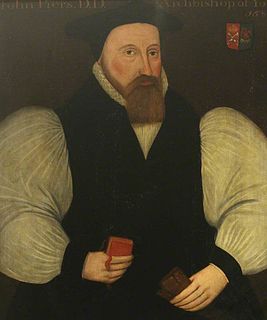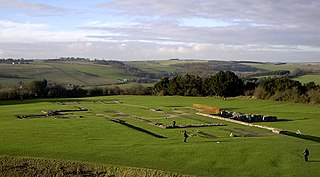
Old Sarum is the site of the earliest settlement of Salisbury in England. Located on a hill about 2 miles (3 km) north of modern Salisbury near the A345 road, the settlement appears in some of the earliest records in the country. It is an English Heritage property and is open to the public.

John Douglas was a Scottish scholar and Anglican bishop.

Richard Poore or Poor was a medieval English clergyman best known for his role in the establishment of modern Salisbury and its cathedral at their present location, away from the fortress at Old Sarum.
John Kite was successively Archbishop of Armagh, 1513–1521, and Bishop of Carlisle, 1521–1537.

John Piers (Peirse) was Archbishop of York between 1589–1594. Previous to that he had been Bishop of Rochester and Bishop of Salisbury.
David Staffurth Stancliffe is a retired Church of England bishop. He was Provost of Portsmouth Cathedral from 1982 to 1993, and the Bishop of Salisbury from 1993 to 2010. He is the third generation of his family to serve the ordained ministry.
Alexander Hyde (1598–1667) was an English royalist clergyman, Bishop of Salisbury from 1665 to 1667.
Nicholas Charles Holmes is an English former professional footballer. He won the FA Cup Final with Southampton in 1976 and, from July 2002 to July 2009, was manager of Salisbury City.

Walter de la Wyle was the Bishop of Salisbury from 1263 to 1271. He was also a subcentor of Salisbury. Walter de la Wyle's is most famous for founding the St. Edmund's College and creating a new parish of St. Edmund's to serve the growing population of Salisbury. The College was also meant to help support the growing university at Salisbury.

Adrian Batten was an English organist and Anglican church composer. He was active during an important period of English church music, between the Reformation and the Civil War in the 1640s. During this period the liturgical music of the first generations of Anglicans began to diverge significantly from music on the continent. Among the genres developed during this period by Batten and other Anglican composers was the 'verse anthem', in which sections alternate between the full choir and soloists, underlain and unified by an independent organ accompaniment.
Robert Andrew Willis, DL is an Anglican priest, theologian, chaplain and music composer. He has been Dean of Canterbury since 2001. He was previously a chaplain and vicar before serving as the Dean of Hereford between 1992 and 2000.

Richard Mitford was an English bishop of Chichester from 17 November 1389, and consecrated on 10 April 1390 and then bishop of Salisbury. He was translated to the see of Salisbury on 25 October 1395.

Salisbury Cathedral School is a co-educational independent school in Salisbury, Wiltshire, England. It was founded in 1091 by Saint Osmund at Old Sarum.

Salisbury Cathedral from the Bishop's Grounds is an 1823 painting by the nineteenth-century landscape painter John Constable (1776–1837). This image of Salisbury Cathedral, one of England's most famous medieval churches, is one of his most celebrated works, and was commissioned by one of his closest friends, John Fisher, The Bishop of Salisbury.

John Fisher, DD was a 19th-century Church of England bishop, serving as Bishop of Exeter, then Bishop of Salisbury.
The Very Reverend Robert Holmes was an English churchman and academic, Dean of Winchester and a biblical scholar known for textual studies of the Septuagint.

John Thomas (1691–1766) was an English Bishop of Lincoln and Bishop of Salisbury.

Old Sarum Cathedral was a Catholic and Norman cathedral at old Salisbury, now known as Old Sarum, between 1092 and 1220. Only its foundations remain, in the northwest quadrant of the circular outer bailey of the site, which is located near modern Salisbury, Wiltshire, in the United Kingdom. The cathedral was the seat of the bishops of Salisbury during the early Norman period and the original source of the Sarum Rite.















